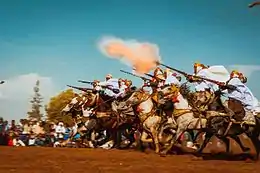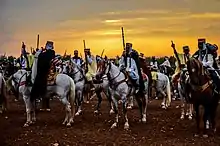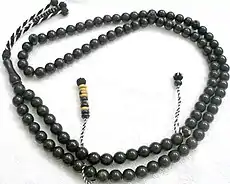Mawsim
| Part of a series on Islam Sufism |
|---|
|
|
Mawsim (Arabic: موسم), or Waada or Raqb, is the term used in the Maghreb, mainly in Algeria, to designate an annual regional festival, in which the Marabout or Sufi Tariqa religious celebrations usually join worshiped locally, festive and commercial activities. These are very popular events, which people from very distant places can attend.[1][2]
Presentation
The Mawsim is an originally religiously motivated festival pilgrimage in the Maghreb in honor of a Saint (Sheikh, Sidi or Moulay).[3]
In this respect, it is accompanied by the equestrian games called fantasias that sometimes take place at such an event and through other cultural peculiarities.[4]
The religiously related festivals are often based on the Islamic calendar and thus take place in different hijri months each year changing.[5]
Many of the Algerian fantasia troupes perform horse exhibition shown several times a year in different cultural events or Mawsims such as the Celebration of Sidi Ahmed al-Majzoob in Naâma, the Horse celebration in Tiaret, or the Celebration of Sidi Yahia Bensafia in Tlemcen.[6]
These festivities of the Mawsims are for the most part cultural events linked to the harvest, to Muslim saints or to nature, so these local festivals are mainly religious but also secular.[7]
The origin of the name Waada comes from the word waad meaning "meeting" and "gathering", while the name Raqb indicates the pedestrian and equestrian procession of the murids from all sides towards the place of the customary or ritual festival.[8]
The most important Algerian moussem of the territory is that of the oasis of Béni Abbès in the region of Bechar.[9]
History
Mawsims or fantasias include equestrian games as a tradition of regional pilgrimages linked to one another in Islamic times.[10]
In the Berber areas of the Maghreb, almost every village had its saint or marabout and a small domed tomb or mausoleum (qubba) of the same name.[11]
Some marabout buildings are still being maintained and whitewashed with white paint every few years.[12]
This feast or ritual of the marabout is celebrated once a year and worshipers come to it from places far away.[13]
Many do not really have a link to a saint or founder, but are annual regional meetings designated for a social or economic purpose.[14]
Practices

The religious practices relating to the Mawsim are based on the Tilawa of the complete and integral sixty Hizbs of Quran called Salka.[15]
A collective recitation of Al-Burda's poem adorns the festivities to dry up praise for Prophet Muhammad before the occurrence of the Mawlid celebration and before visiting his tomb in the Al-Masjid an-Nabawi in Medina.[16]
Collective catering around large couscous dishes is a central quality of these festivities in order to socialize people attending the Mawsim around traditional culinary foods in addition to the recitation of the Quran, Dhikr and Qasidas.[17]
The annual gathering of the descendants of the marabout in this festivity is an opportunity to strengthen family and tribal ties between these cousins, and also to establish family alliances with other siblings and tribes.[18]
These religious, sociological and gastronomic aspects make it possible to weld the cultural and existential breaches of patriarchal societies and to preserve the intangible heritage of populations, especially rural ones.[19]
Group Salah, collective Tarteel, team tasting of dishes and couscous, choral singing of Al-Burda, appreciation of the artistic performances of fantasia, humming of poems and qasidas, as well as other activities, make Mawsim a proven factor of social cohesion and individual appeasement.[20]
References
- "سكان وهران يتحسرون على وعدة سيدي الحسني". جزايرس.
- "وعدة سيدي محمد بن يحيى بتيسمسيلت ". جزايرس.
- "ضريح سيدي عبد الرحمن". www.alaraby.co.uk/.
- "وعدة حناشة .. إطعام وصدقات على أمل موسم فلاحي ناجح". جزايرس.
- "الزوار "يحجّون" إلى ضريح سيدي عبد الرحمن". جزايرس.
- "غليزان: إقبال كبير للزوار على وعدة الولي الصالح سيدي بوعبد الله". Aps.dz. Retrieved 2021-01-24.
- "زيارة سيدي عبد الرحمن تقليد شعبي يثير الجدل". جزايرس.
- "وعدة سيدي أحمد المجدوب ببلدية عسلة تستقطب آلاف الزوار". جزايرس.
- "الوعدة السنوية لسيدي محمد السايح بغرداية تجمع شمل الجزائريين". الشروق أونلاين. July 1, 2019.
- ""وعدة" سيدي محمد والشيخ شموع، كسكسي وأشياء أخرى". جزايرس.
- "وعدة سيدي الحسني.. تظاهرة لم يبق منها إلا الاسم". جزايرس.
- "إحياء وعدة الولي الصالح سيدي سحنون التقليدية ببلدية أولاد بن عبد القادر". جزايرس.
- "أهل فليتة يحتفلون بوعدة الولي الصالح سيدي محمد بن عودة". جزايرس.
- الحليم, ❊ل عبد. "إحياء وعدة الولـي الصالح "سيدي أمحمد الواسيني"". المساء.
- "اختتام وعدة " سيدي الحسني " بوهران". جزايرس.
- "تيميمون تتزيّن للإحتفال بأسبوع المولد النبوي". جزايرس.
- "غليزان توافد كبير على وعدة سيدي حراث بزمورة". جزايرس.
- "وعدة سيدي عابد بتيسمسيلت تستقطب الزوار". جزايرس.
- "منطقة وتقاليد وعدة سيدي أحمد المجذوب بالنعامة". جزايرس.
- "المشوي، الكسكسي والرفيس لفتح الشهية". جزايرس.


